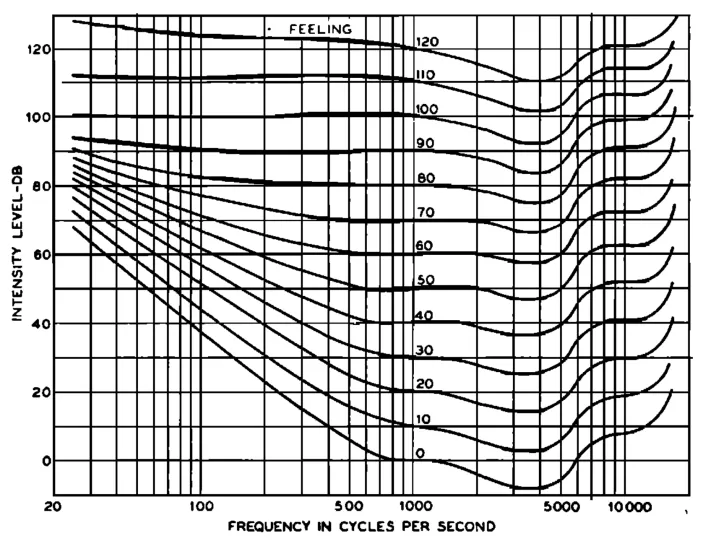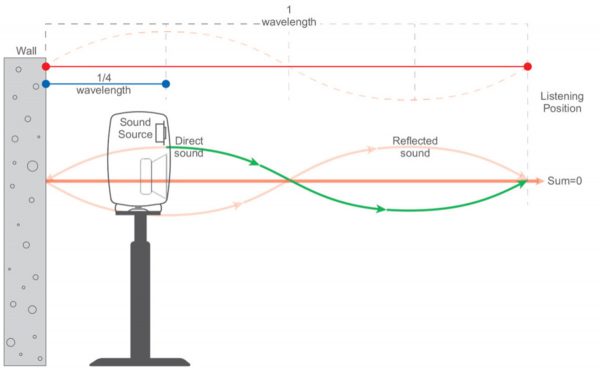Many people frequently ask about whether it’s better to purchase 8” speakers or 5” speakers for their studios. If you have the same question, keep reading till the end.
The main objective of using a pair of studio monitors is to listen 20Hz to 2kHz range at an equal level. The first thing to understand is that there are no speakers that can produce 100% flat frequency response in the world. If any company makes such 100% speakers, you’ll never hear the sound in 100% flat. There are 2 reasons for that.
- The human ear is not sensitive to every frequency at the same level. (Research about the “Equal loudness contour” for better understanding)

Equal Loudness Contour
Check the article at iZotope website on this
2. Acoustical impact due to the placement of the speaker and its surroundings
Okay. Let’s get back to the first point. The main objective of using a pair of studio monitors is to listen 20Hz to 2kHz range at an equal level.
If we think simply about the requirement, it’s obviously 8” speakers are better. Because an 8” speaker is capable of producing above 30Hz at an audible level. Then why there are smaller speakers in the market?
When a loudspeaker produces a sound, it will compress the air around accordingly. That’s how a sound wave travels. If we consider the lowest 20Hz frequency we hear, it will travel around 17m during a 1 cycle of time. We call it the “Wavelength”. Similarly, a 20kHz wave has a wavelength of around 1.7cm.
Hope you get the relationship between frequency and wavelength. Lower frequencies have longer wavelengths while higher frequencies have shorter ones.
So if any dimension (length, width or height) of your studio room is less than 17m, the 20Hz and lower frequencies are not free to move in that space. Yes, you heard it right! It’s not practical to find such a room that exceeds 17m in all 3 dimensions. That means all of us have low-frequency problems in our rooms. Let’s discuss more.
The most impactful low-frequency problem in a room is the impact of “Room modes”. This means, according to the size of your room, some frequencies in the lower region will create boosts and cancellations at different locations of the room.

3 types of Room Modes
Check the article at mixdownmag.com on room modes
It’s not possible to avoid this impact. But able to minimize and control after an acoustical treatment which should be conducted after a proper calculation. Acoustic foams or curtains will not have any impact on room modes.
Check our previous article on room acoustics treatments – https://audiblepro.com/blogs/educational/the-secret-to-perfect-sound-why-your-room-needs-to-be-acoustically-treated/
If you use an 8” speaker pair, both low and high frequencies will be produced by the speaker drivers in the same enclosure. Therefore we do not have any manual control of the low frequencies to make adjustments according to the room mode impact. Therefore it’s better to use a 5” speaker if you have a smaller room. But you’ll definitely require a separate subwoofer to produce the low end up to 60Hz. Because smaller speakers are not capable of producing low frequencies at an audible level. When you add a subwoofer apart from small-sized main L/R speakers, it’s a must to phase align all 3 speakers. We can do it in both ways of analog and digital. Don’t forget to comment if you’re interested in reading about phase alignment and I’ll write on it too.
The next thing is the front wall reflection of sound when you place speakers. When we place our studio monitors in an equally distanced triangle with the listening position, direct sound from the speakers is not the only sound we get to the listening position. There will be a problematic reflection from the front wall which will completely cancel out some frequency according to the distance between the speaker driver and the front wall (wall behind the speaker). We call it a phase cancellation.

Front wall (Rear wall for speakers) cancellation
Read the article "HOW FAR FROM THE WALL SHOULD I PLACE MY MONITORS?" at studioconnections.com
The cancellation frequency will tend to be higher range when speakers are getting closer to the wall. Therefore we can add a sound absorption panel of suitable material and thickness to isolate the reflection. But if we have full range 8” speakers, getting closer to the wall will buildup a boost in low frequencies. Here’s the reason. As we know, the lower frequencies are omni directional. But when the low frequency producing speaker getting nearby a boundary, it starts to direct the energy of sound to the boundary to the opposite side. Which occurs a Half-sphere shaped propagation of sound with added pressure to the room. Very similar to double the power of the subwoofer.
So, now you understand, go for small main speakers with a subwoofer if you have a smaller room.
Finally, Most people are familiar with only 8” and 5” because they are the most common. But if you have a technical idea, you have many options available in the market. I’ll put a few links below for such low-budget products.
- Presonus (Eris E3 + Eris Sub 8BT)
- Thomann
- Eris E3 – https://thmn.to/thoprod/572877?offid=1&affid=1552
- Eris Sub 8BT – https://thmn.to/thoprod/572888?offid=1&affid=1552
- Amazon
- Eris E3 – https://amzn.to/46wbVuH
- Eris Sub 8BT – https://amzn.to/3GjJqG8
- Thomann
- Mackie (CR3-X + CR8S-X BT)
- Thomann
- Amazon
- CR3-X – https://amzn.to/47n8vvz
- CR8S-X BT – https://amzn.to/40V7oAO




